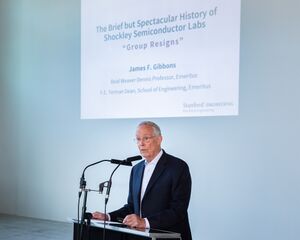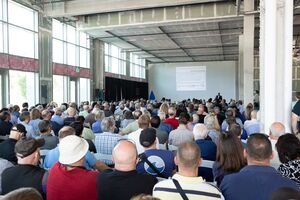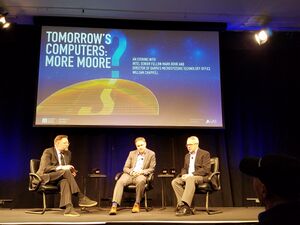Milestones:Birthplace of Silicon Valley, 1956
- Date Dedicated
- 2018/08/15
- Dedication #
- 188
- Location
- Mountain View, CA
- IEEE Regions
- 6
- IEEE sections
- Santa Clara Valley
- Achievement date range
- 1956

Title
Birthplace of Silicon Valley, 1956
Citation
At this location, 391 San Antonio Road, the Shockley Semiconductor Laboratory manufactured the first silicon devices in what became known as Silicon Valley. Some of the talented scientists and engineers initially employed there left to found their own companies, leading to the birth of the silicon electronics industry in the region. Hundreds of firms in electronics and computing can trace their origins back to Shockley Semiconductor.
Street address(es) and GPS coordinates of the Milestone Plaque Sites
391 San Antonio Rd., Mountain View, CA 94040 US (GPS: 37.405434, -122.110827)
Details of the physical location of the plaque
The plaque is mounted on a wall facing San Antonio Rd., just south of the corner of California St., in what is called the Monument Area. It is incorporated into the upper left corner of a "Superplaque" which includes photos and details related to the Birth of Silicon Valley. A large captioned photo of this Superplaque is included below. To the left of the Superplaque are large sculptures of a transistor and 2 diodes, and to the right is a large "391" address sculpture.
How the plaque site is protected/secured
The Monument Area is very close to the street; it is maintained by the site owners and the City of Mountain View, and is accessible 24/7
Historical significance of the work
In bringing the first silicon semiconductor device production to Silicon Valley launched an industry. More than 400 firms in electronics can trace their genealogy to Shockley Laboratory. Silicon transistors and ICs are the basis of the electronic industry.
Obstacles (technical, political, geographic) that needed to be overcome
The opening of Shockley Labs in 1955 required building of a semiconductor facility which grew silicon crystals and processed silicon devices. This was the first such facility in "Silicon Valley" for the manufacture of silicon devices.
Features that set this work apart from similar achievements
The development of the first silicon based semiconductor devices in Silicon Valley, In addition the hiring of an outstanding team of semiconductor scientists, many of which later on founded Fairchild Semiconductor.
Significant references
https://www.youtube.com/watch?v=0KG7JzzU1tw
http://www.mv-voice.com/morgue/2000/2000_12_15.shockley.html
https://www.youtube.com/watch?v=yLNh4UY5ohw
http://wikitravel.org/en/Silicon_Valley
http://wikitravel.org/en/Talk:Birthplace_of_Silicon_Valley
http://bits.blogs.nytimes.com/2008/09/12/buying-tomatoes-at-the-birthplace-of-silicon-valley/
"Birth of Silicon Valley" Sunday Business, San Jose Mercury News, January 27,2013
Riordan, Michael and Hoddeson, Lillian, Crystal Fire, W. W. Norton & Company, 1997, p 232-253
Lojek, Bo, History of Semiconductor Engineering, Springer, 2007, p 67- 101
Lecuyer, Christophe and Brock, David C, Makers of the Microchip, The MIT Press, 2010, p 12-14.
Cassidy: Readers invent ways to honor birthplace of Silicon Valley http://www.mercurynews.com/mike-cassidy/ci_23003899/cassidy-readers-inspire-ways-honor-birthplace-silicon-valley
Shockley, William and Jones, Richard V. "Crystal Growing Apparatus," U. S. Patent 2,979,386 (Filed August 2, 1956. Issued April 11, 1961)
Sah, C.T., Noyce, R.N., Shockley, W. "Carrier Generation and Recombination in p-n Junction and p-n Junction Characteristics," Proceedings of the IRE, Vol. 45, No. 9 (September 1957), pp. 1228-1243.
Sah, C.T., Sello, H., Tremere, D.A. "Diffusion of Phosphorus in Silicon Oxide Film." J. Phys. Chem. Solids Vol. 11 (1959) p. 288.
The Shockley banner. JPG titled "The Birthplace of Silicon Valley" shows the Shockley Labs legacy. It is resident at the Computer History Museum. It is also shown in http://siliconvalley.sutromedia.com/shockley-semiconductor-lab.html
PBS, American Experience: Silicon Valley https://www.youtube.com/watch?v=VeL4t5bvTj4&NR=1&feature=endscreen
The following url writes about Silicon Valley http://en.wikipedia.org/wiki/Silicon_Valley An excerp form this writeup says: "Silicon transistor and birth of the Silicon Valley[edit]
In 1953, William Shockley left Bell Labs in a disagreement over the handling of the invention of the transistor. After returning to California Institute of Technology for a short while, Shockley moved to Mountain View, California in 1956, and founded Shockley Semiconductor Laboratory." This article was pointed to by Ted Bickart
Supporting materials
Birthplace of Silicon Valley: Story of this Public Art Project
US Representative Zoe Lofgren Resolution for this Milestone
Where is the Birthplace of Silicon Valley? (8 August 2018)
Grocery market at 391 San Antonio Rd. prior to major renovations
Media:Shockley Building Road Sign.jpg
Cassidy: Shockley's lab has no shortage of would-be saviors
By Mike Cassidy Mercury News Columnist San Jose Mercury News
Posted:
MercuryNews.com
MOUNTAIN VIEW -- Now that the end times are here for the building that rightfully claims to be the birthplace of Silicon Valley, there is no shortage of ideas about how to commemorate the spot where the valley's pioneers first put silicon to work in an effort to build the world's first practical semiconductor.
The truth is, the work at Shockley labs at 391 San Antonio Road did lead to that chip, but not in a straight-line sort of way. Instead digital ground was truly broken when eight of William Shockley's employees, known as the Traitorous Eight, left him in 1957 to form their own company.
Now that the building is slated to be torn down to make way for a huge development, any number of proposals have surfaced to save it, memorialize it, enshrine it, etc.
I have my own proposal, incorporating part of the old Shockley building into the new construction. I shared my vision in a column that you can find at http://www.mercurynews.com/mike-cassidy. And I've asked you to send your ideas to me at mcassidy@mercurynews.com or to send them on Twitter at @mikecassidy.
The interest in the old lab isn't surprising. The building, a many times made-over structure, is almost mythical in the minds of those who care about how Silicon Valley got its start.
"That is where Shockley hired a brilliant bunch of people," says David Laws, a curator at the Computer History Museum and one of the foremost experts on the history of the semiconductor industry. "Many of them went on to brilliant careers from there. A lot of buildings have been celebrated for a lot less."
Yes, among the Shockley crowd were Robert Noyce and Gordon Moore, who went on to co-found Intel (INTC); and Jean Hoenri, who came up with the first practical way to mass produce semiconductors; and Eugene Kleiner, who helped found Kleiner Perkins, the venture capital company that invested in Sun Microsystems, Netscape, Google (GOOG), Electronic Arts (ERTS), Amazon and AOL to name a few. Moreover, historians say that as many as 400 companies, or Fairchildren, trace their roots to Fairchild.
So, the ideas: The boldest (and as is the case with bold things, perhaps the least likely) is being put forth by retired Palo Alto attorney Harold Hohbach, himself a bit of a character. Hohbach would like developer Merlone Geier Partners to give the building to a non-profit that would operate it as a museum, complete with replicas of artifacts of Shockley's time.
"Just seeing an old building will never get you anywhere," Hohbach says. "I think it's important to preserve the technology that they developed in that building."
Hohbach doesn't have just a passing fancy in the history of Silicon Valley. The 91-year-old says his law partner was William Shockley's patent attorney. Not only that, he's spent the past decade commissioning and attempting to curate a series of seven huge paintings depicting innovators grouped around their breakthroughs. There's Shockley, Noyce and Moore. There's Russell Varian, Ray Dolby, Reynolds Johnson, Douglas Englebart, Gene Amdahl, Steve Wozniak and on and on.
Hohbach realizes there are details to work out with his plans for 391 San Antonio -- such as who is going to pay for all this. But he is not one to back down even from a long shot.
When it comes to proposals for the building, the odds on favorite, no doubt, is the preliminary one put forth by Merlone Geier. The company owns the building, after all, and is the midst of a $500-million remake of the old San Antonio Center. To their credit, the executives at Merlone Geier know they are now the stewards of an important legacy. The Shockley building itself does not delight them. It is old and ugly and in disrepair. But the story of the rise of Silicon Valley enthralls them.
"I think a lot of people would look at this as, 'Oh gee, now I have to deal with this issue," says Merlone Geier vice president Mike Grehl. "To me, this is going to be a neat amenity to the project to create a uniqueness."
What Merlone Geier has in mind is an artistic memorial at the site of the building on San Antonio Road. Then the developer would add an educational area, perhaps in an outdoor plaza in the development, that would tell the story of what happened in Shockley labs and how that spawned Silicon Valley and the digital revolution.
The company has enlisted a couple of former Shockley employees and Dick Ahrons, of the IEEE, an organization of electrical and electronics engineers. He likes the idea of an artistic memorial and what he calls a "technology plaza" that would be open to the public.
My idea for the building, he says, raises a number of issues.
"I thought about keeping the front part of the building, as a facade. And you look at it and you look at it and, it's just not there anymore," he says, noting that the building has been through extensive remodels.
He says my idea -- using the facade as an office building entryway stocked with replicas of Shockley-era tools and devices -- would require constant upkeep. And it would place the memorial inside a private building, which might restrict public access. Artifacts of the era, he says, belong at the nearby Computer History Museum (which does have some Shockley artifacts). And maybe some sort of facade idea would work there, too, though it would be quite an expense to refurbish the facade and move it across town.
"If it's at the museum, it's open to the public and so on," he says.
The good news in all this is that the people coming up with these ideas all care about preserving the history of how 391 San Antonio Road changed the world. And better still, chances are that new ideas will continue to surface as the discussion goes on.
Contact Mike Cassidy at mcassidy@mercurynews.com or 408-920-5536. Follow him at Twitter.com/mikecassidy.
Bronze Plaque and roadside sign. http://wikimapia.org/23273177/Shockley-Semiconductor-Laboratory-markers
(Richard Ahrons is presently a member of the committee organized by the property owners to memorialize the site. The present plan is to erect a memorial artistic sculpture at the site. Richard Ahrons has presented the case for this site before the Mtn. View City Council)
Map







